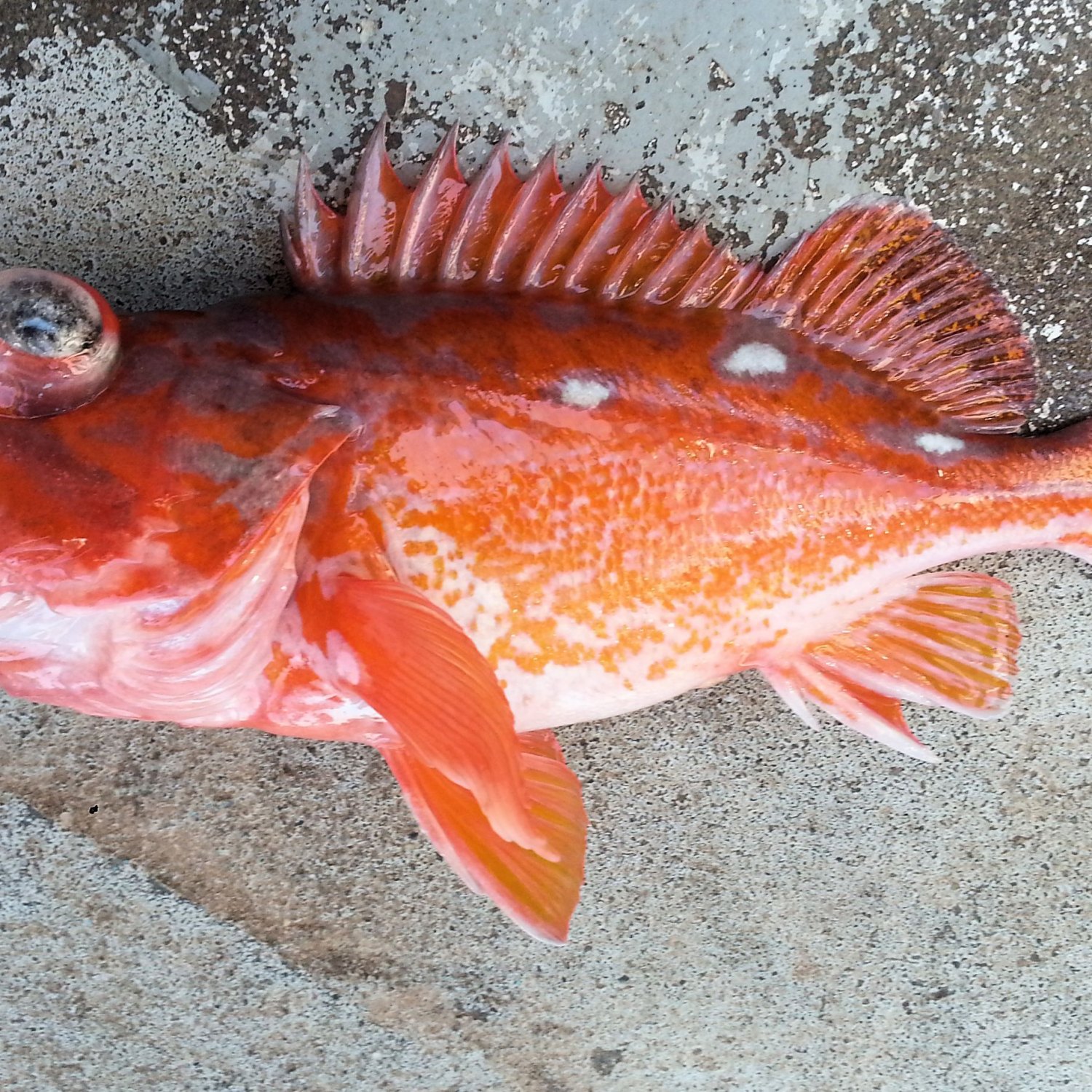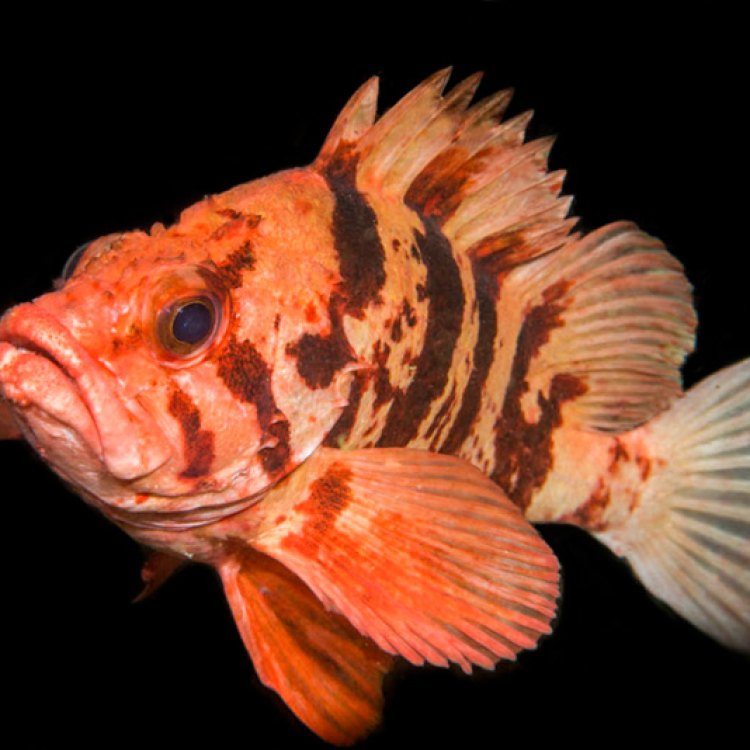
Rockfish
Varies depending on the species, ranging from 10 to 39 inches (25 to 100 cm)
Rockfish, a favorite among anglers and seafood lovers, are a type of fish that can be found near rocky reefs and structures underwater. With a deep-bodied and compressed shape, they come in various species, ranging from 10 to 39 inches. They belong to the Sebastidae family and are known for their delicious taste and vibrant colors. Next time you are near the ocean, keep an eye out for these diverse and fascinating creatures! #Rockfish #Fishing #Seafood
Animal Details Summary:
Common Name: Rockfish
Kingdom: Animalia
Habitat: Marine
The Fascinating World of Rockfish: A Closer Look at the Colorful and Powerful Fish of the Northern Pacific Ocean
When it comes to the diverse and wondrous world of marine life, one particular type of fish that stands out is the rockfish. These stunning and powerful creatures can be found dwelling in the coastal waters of the northern Pacific Ocean, known for their vibrant colors, unique body shape, and exceptional survival skills.But what makes rockfish so fascinating? Let's dive in and explore the enchanting world of the rockfish, from their scientific classification to their geographical distribution, coloration, body shape, and more.
Scientific Classification
The scientific name for rockfish is Sebastes, a genus of fish in the Sebastidae family Rockfish. This family is part of the Actinopterygii class, commonly known as ray-finned fishes. Rockfish belong to the order Scorpaeniformes, which includes other fish species such as scorpionfish, lionfish, and stonefish. All these fishes are known for their spiny and venomous nature.Geographical Distribution
Rockfish primarily inhabit the coastal waters of the northern Pacific Ocean, spanning from the Sea of Japan to the Gulf of Alaska. They can also be found in the Bering Sea and down to the coasts of California in the United States. These fish tend to live in the depths of the ocean, ranging from 300 to 1100 feet (90 to 335 meters) below the surface.Habitat
Rockfish are benthic, meaning they dwell at the bottom of their aquatic ecosystem. They are often found near rocky reefs and underwater structures, where they can hide and find prey. These fish are known for their exceptional camouflage, blending in with their surroundings to avoid predators Red Handed Tamarin.Feeding Habits
Rockfish are carnivorous and have an insatiable appetite. They feed on a variety of marine creatures, including crustaceans, mollusks, small fish, and even other rockfish. These fish have a strong jaw that allows them to crush the shells of their prey. They also rely on their excellent vision to spot and capture their food.Coloration
One of the most striking features of rockfish is their colorful appearance. Their coloration varies depending on the species, often ranging from various shades of red, orange, brown, and black. This colorful display serves as a form of camouflage, allowing them to blend in with their environment and avoid detection from predators.Body Shape and Size
Rockfish have a unique deep-bodied and laterally compressed shape, making them well-adapted for living near the ocean floor. This body structure allows them to navigate through rocky reefs and crevices with ease. The size of rockfish also varies depending on the species, with some reaching up to 39 inches (100 cm) in length.Survival Skills
Apart from their incredible colors and body shape, rockfish also possess impressive survival skills. One of their most notable abilities is their longevity. Some rockfish species can live up to 120 years, making them one of the longest living fish species in the world. They also have a slow growth rate, which contributes to their long lifespan.Another impressive feature of rockfish is their ability to regulate their buoyancy, allowing them to hover in the water without much effort. This skill is crucial for their survival as it helps them conserve energy and avoid being swept away by strong currents.
Dangerous Beauty
While rockfish may seem like serene and mesmerizing creatures, they can also be quite dangerous. As mentioned earlier, they are part of the Scorpaeniformes order, which includes venomous fishes. Their sharp spines are loaded with venom, making them a threat to predators and even humans. Accidental envenomation from a rockfish can cause severe pain, swelling, and even paralysis.Commercial and Recreational Use
Rockfish are highly sought after in commercial and recreational fishing. In some areas, they are considered a delicacy and are often sold in fish markets. However, rampant fishing of rockfish has led to a decline in their population in some regions, leading to conservation efforts to protect these valuable creatures.In recreational fishing, rockfish are a popular target for anglers due to their strong fighting abilities and the challenge they provide. However, there are regulations in place to ensure responsible and sustainable fishing practices to conserve the population of rockfish.
In Conclusion
The rockfish is undoubtedly a remarkable and enchanting creature, with its colorful appearance, unique body shape, and impressive survival skills. From their scientific classification to their feeding habits, geographical distribution, and commercial and recreational use, rockfish have captured the curiosity and admiration of many.But beyond their physical features and uses, rockfish serve as a reminder of the vast and diverse world that our oceans hold. As responsible stewards of the environment, it is essential to protect and conserve the population of these fascinating creatures to ensure their longevity for generations to come.

Rockfish
Animal Details Rockfish - Scientific Name: Sebastes
- Category: Animals R
- Scientific Name: Sebastes
- Common Name: Rockfish
- Kingdom: Animalia
- Phylum: Chordata
- Class: Actinopterygii
- Order: Scorpaeniformes
- Family: Sebastidae
- Habitat: Marine
- Feeding Method: Carnivorous
- Geographical Distribution: Coastal waters of the northern Pacific Ocean
- Country of Origin: United States, Canada, Russia, Japan
- Location: Rocky reefs and underwater structures
- Animal Coloration: Varies depending on the species, ranging from various shades of red, orange, brown, and black
- Body Shape: Deep-bodied and laterally compressed
- Length: Varies depending on the species, ranging from 10 to 39 inches (25 to 100 cm)

Rockfish
- Adult Size: Varies depending on the species, ranging from 10 to 39 inches (25 to 100 cm)
- Average Lifespan: Varies depending on the species, ranging from 20 to 100 years
- Reproduction: Sexual
- Reproductive Behavior: External fertilization
- Sound or Call: Most species do not produce sound or calls
- Migration Pattern: Some species migrate seasonally
- Social Groups: Often solitary, but may form aggregations during feeding or spawning
- Behavior: Nocturnal and territorial
- Threats: Overfishing, habitat destruction, pollution
- Conservation Status: Varies depending on the species, some are endangered or critically endangered
- Impact on Ecosystem: Important predators in their ecosystems, help maintain balance in marine food webs
- Human Use: Commercial and recreational fishing
- Distinctive Features: Spiny fins, large mouths, and prominent eyes
- Interesting Facts: Rockfish are one of the longest-lived fish species in the world, some can live up to 100 years
- Predator: Various larger predatory fish and marine mammals prey on rockfish

Sebastes
The Fascinating World of Rockfish: Discovering the Secrets of These Ancient Predators
Hidden beneath the seemingly endless expanse of the ocean lies a world teeming with unique and diverse creatures. One such creature is the rockfish, a group of fish known for their spiny fins, large mouths, and prominent eyes. These fascinating creatures are found in different parts of the world, ranging from the Pacific Ocean to the Atlantic Ocean. With over 100 different species, rockfish are a vital part of the marine ecosystem and have captured the attention of scientists and fishermen alike PeaceOfAnimals.Com.In this article, we will take a closer look at the distinctive features, behavior, and importance of rockfish in their ecosystem. From their impressive lifespan to their impact on the environment, we will uncover the secrets of these ancient predators.
Rockfish: A Diverse Family of Fish
The rockfish family, also known as Sebastidae, is a large and diverse group of fish that belongs to the order Scorpaeniformes. They are found in various habitats, including coral reefs, rocky shores, and deep oceans. Depending on the species, rockfish can vary greatly in size, with some reaching up to 39 inches in length.Their physical appearance is what sets them apart from other fish species. Their spiny fins and large mouths are well-suited for their bottom-dwelling lifestyle. They also have prominent eyes, which give them an almost comical expression. If you ever come across a rockfish, you will surely remember their unique and distinctive appearance Roe Deer.
The Long and Mysterious Life of Rockfish
One of the most remarkable features of rockfish is their incredibly long lifespan. Some species can live up to 100 years, making them one of the longest-lived fish species in the world. The exact lifespan depends on the species, with the oldest recorded rockfish being a 205-year-old female from Alaska.The longevity of rockfish has puzzled scientists for decades. It is believed that their slow growth rate and low reproductive rate contribute to their long lifespan. Some species of rockfish don't reach reproductive maturity until they are 10-20 years old. This, combined with their external fertilization process, makes it difficult for them to replenish their populations quickly.
The Unique Reproductive Behavior of Rockfish
Unlike many other fish, rockfish reproduce sexually through external fertilization. This means that the female releases her eggs into the water, and the male fertilizes them externally. This process usually occurs during the spring and summer months when the water temperature is warmer.Rockfish tend to be solitary creatures, only coming together for reproductive purposes. However, during spawning season, they gather in large aggregations, making it easier for them to find mates. This behavior is essential for maintaining their population levels, which have been declining in recent years due to various threats.
Threats to Rockfish: Why They Need Our Help
Rockfish, like many other marine creatures, are facing numerous threats that are putting their populations at risk. Overfishing, habitat destruction, and pollution are the most significant threats to their survival. Due to their slow growth and reproductive rates, rockfish are more susceptible to the effects of overfishing. This is a major concern, as many species are being harvested at an unsustainable rate.Habitat destruction is another significant threat to rockfish. They depend on rocky habitats for shelter and protection from predators. However, human activities such as bottom trawling and dredging have resulted in the destruction of these habitats, leaving rockfish vulnerable and exposed.
Pollution is also a significant concern for rockfish. Chemicals, plastics, and other forms of pollution can harm them and their habitats, disrupting their natural behavior and life cycles. It is essential to address these threats to ensure the survival of rockfish and maintain balance in marine ecosystems.
The Important Role of Rockfish in Their Ecosystem
In addition to being fascinating creatures, rockfish also play a vital role in their ecosystem. As predators, they feed on a variety of prey, including crabs, shrimp, and small fish. This helps maintain balance in marine food webs, preventing overpopulation of certain species and allowing others to thrive.Rockfish are also a food source for various larger predatory fish and marine mammals. Their ability to thrive in different habitats makes them an essential part of the food web, ensuring the survival of other species.
The Human Use of Rockfish
Apart from their ecological importance, rockfish also have significant economic value for humans. Commercial and recreational fishing have been the primary uses for rockfish, with over 50 species being targeted for consumption. Rockfish are not only valued for their meat, but they are also popular game fish due to their impressive size and strength.However, unsustainable fishing practices have caused a decline in rockfish populations and have led to stricter regulations and management measures. It is crucial to find a balance between human use and conservation efforts to preserve this species for future generations.
The Legacy of Rockfish: Interesting and Unique Facts
Rockfish have been around for millions of years, and their longevity and adaptability have earned them a special place in the natural world. Here are some interesting and unique facts about rockfish that highlight their incredible features and abilities:- Rockfish are nocturnal and territorial, spending most of their time hidden in crevices or caves during the day.
- They have a series of sensory pores called lateral lines that help them detect prey and navigate through dark and murky waters.
- Some species of rockfish can change color to blend in with their surroundings, making them less visible to predators.
- Rockfish are capable of surviving in low-oxygen environments, thanks to their unique adaptations.
- They are known to make audible grunts and pops using their teeth and swim bladders, although most species do not produce sound or calls.
The Predator and the Prey: The Relationship Between Rockfish and Other Marine Creatures
As mentioned earlier, rockfish are important predators in their ecosystem, feeding on a variety of prey. However, they are also prey for larger predatory fish and marine mammals. Sharks, seals, and sea lions are known to feed on rockfish, while larger fish such as lingcod and halibut also rely on them for sustenance.The cycle of predator and prey in the ocean is crucial for maintaining balance and ensuring the survival of different species. Rockfish, with their impressive abilities and long lifespan, have been playing their part in this intricate web of life for millions of years.
In Conclusion
Rockfish may seem like ordinary fish at first glance, but a closer look reveals their unique and fascinating features. From their longevity to their distinct reproductive behavior, rockfish have adapted to thrive in a variety of habitats and play a crucial role in their ecosystem.However, like many other marine creatures, they are facing numerous threats that require our attention and action. It is our responsibility to ensure the survival of these ancient predators and maintain balance in marine ecosystems. By learning more about them and taking steps to protect their habitats, we can ensure that rockfish continue to thrive for generations to come.

The Fascinating World of Rockfish: A Closer Look at the Colorful and Powerful Fish of the Northern Pacific Ocean
Disclaimer: The content provided is for informational purposes only. We cannot guarantee the accuracy of the information on this page 100%. All information provided here may change without prior notice.












